
Removing tree stumps can be a very difficult task. If it’s not necessary to get rid of them in your area, why not turn them into planters instead?
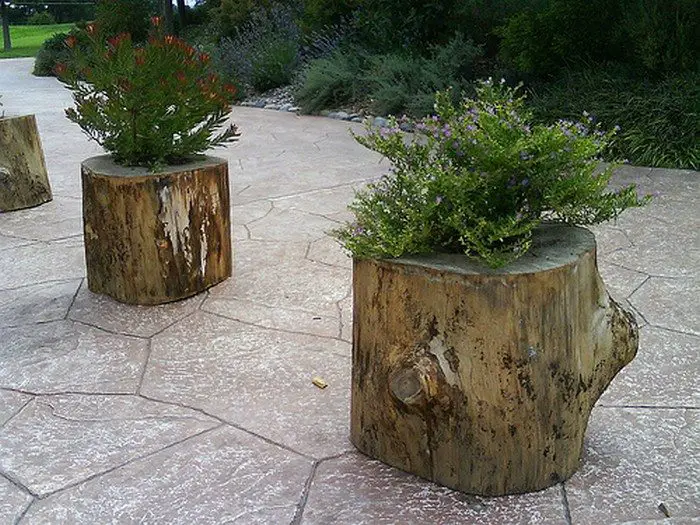
This planter idea is simple. All you have to do is hollow out the center to fill it with soil for your plants to grow in!
You can put any plant or flower that you wish. Some people even make fairy gardens with their tree stumps! No matter which plants you choose, you’re sure to have a lovely and unique feature in your yard. :)
Take a look at some examples from our album below and learn how it’s done!
Contents
Creating a Tree Stump Planter
Materials
- 3/4″ Gravel for drainage
- Potting Soil
- Compost
- Plants of your choice
Tools
- Mattock
- Safety Glasses
- Auger fitted with 3/8 to 1/2″ Bit
- Hand Trowel
Instructions
Step 1: Safety First
Always start with safety. Put on some sturdy safety glasses to protect your eyes from wood chips and dust.
Step 2: Carving Out the Stump
Grab your mattock, a kind of pickaxe, and start chipping away at the stump. Aim to create a hollow space in the middle. This can be a bit of a workout, so take it slow. For precision, use an auger with a 3/8 to 1/2″ bit to drill several holes in the top of the stump. This makes it easier to remove the inner wood later.
Step 3: Clear the Center
After drilling, use the mattock again or switch to a chisel and hammer to scoop out the loosened wood. You’re aiming for a hole about 8-10 inches deep to give plants plenty of room to root.
Step 4: Set Up for Drainage
Poor drainage can doom your planter from the start. Avoid this by adding a layer of 3/4″ gravel at the bottom of your hollowed stump. This helps excess water escape and keeps your plants happy.
Step 5: Soil and Compost Mix
Time for the soil. Mix together potting soil and compost in a 3:1 ratio to give your plants a nutrient-rich environment. Fill the stump with this mixture, but don’t overfill. Leave about an inch of space at the top to prevent overflow when watering.
Step 6: Planting Time
Now the fun part—planting! Pick plants that fit the depth and width of your stump. Flowers, small shrubs, or even succulents can work well. Arrange them aesthetically and use your hand trowel to place them gently into the soil.
Step 7: Water Your New Planter
Give your newly planted stump a good watering. This helps settle everything in place. Make sure the water drains through the gravel layer effectively, which confirms your drainage setup works.
Step 8: Maintain Your Planter
Keep the soil moist, and during hot days, you might need to water more frequently. Adding a layer of mulch can help retain moisture. Trim any overgrown plants to keep your planter looking neat.
Click on any image to start the lightbox display. Use your Esc key to close the lightbox.![]()
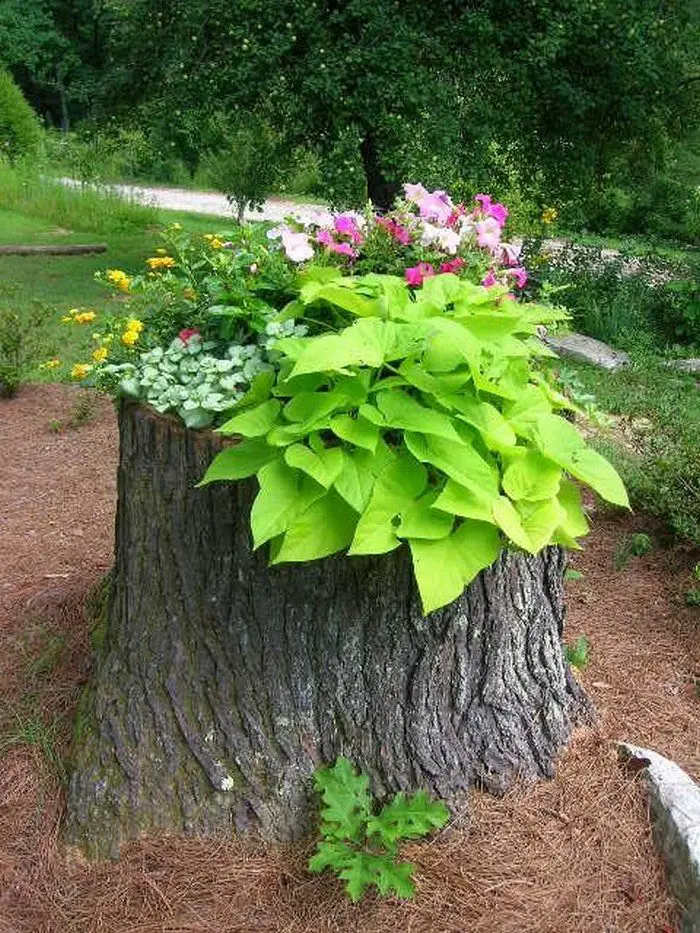
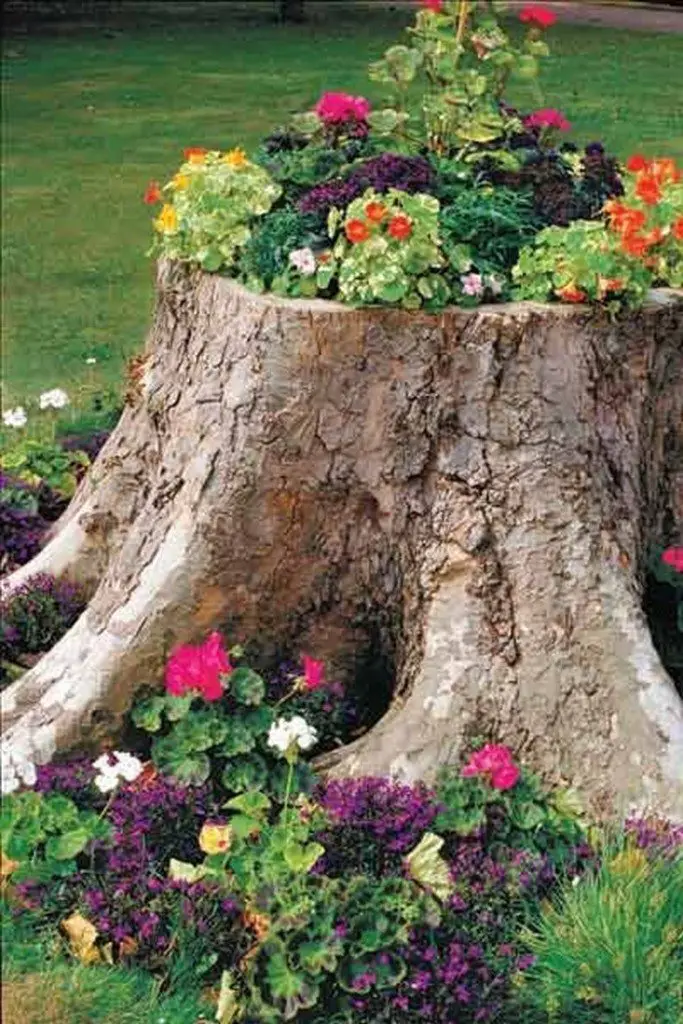
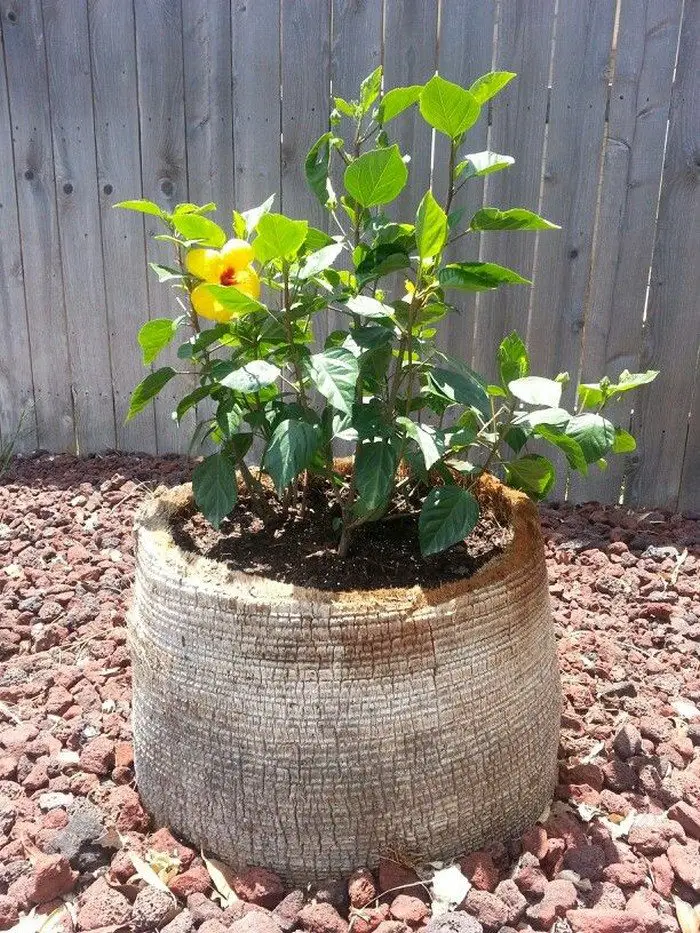
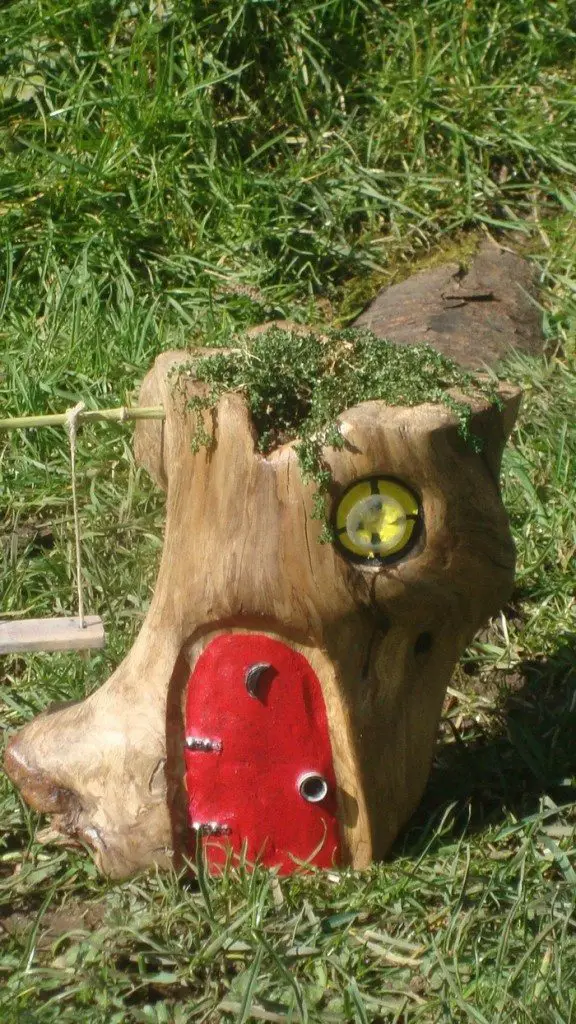
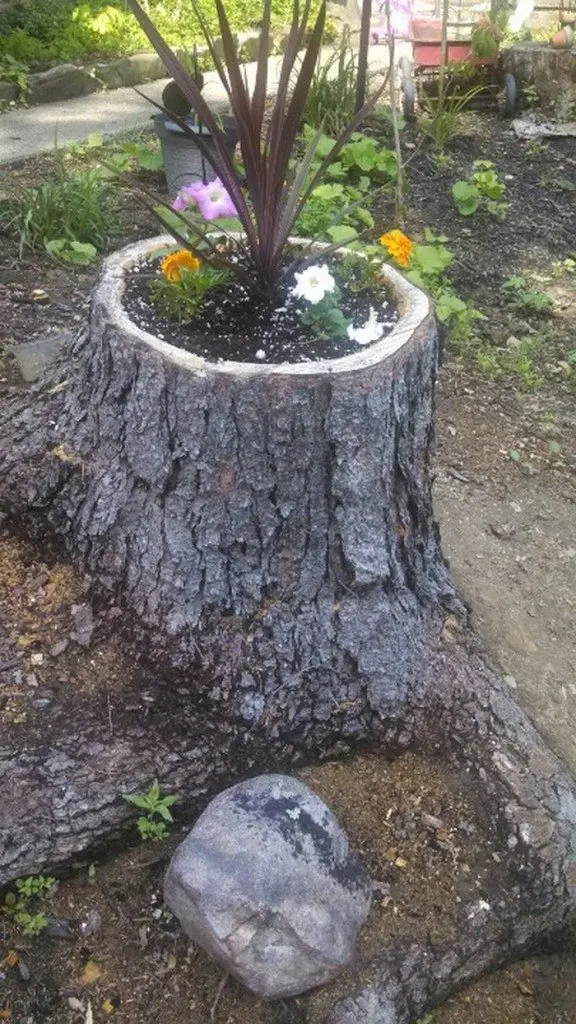
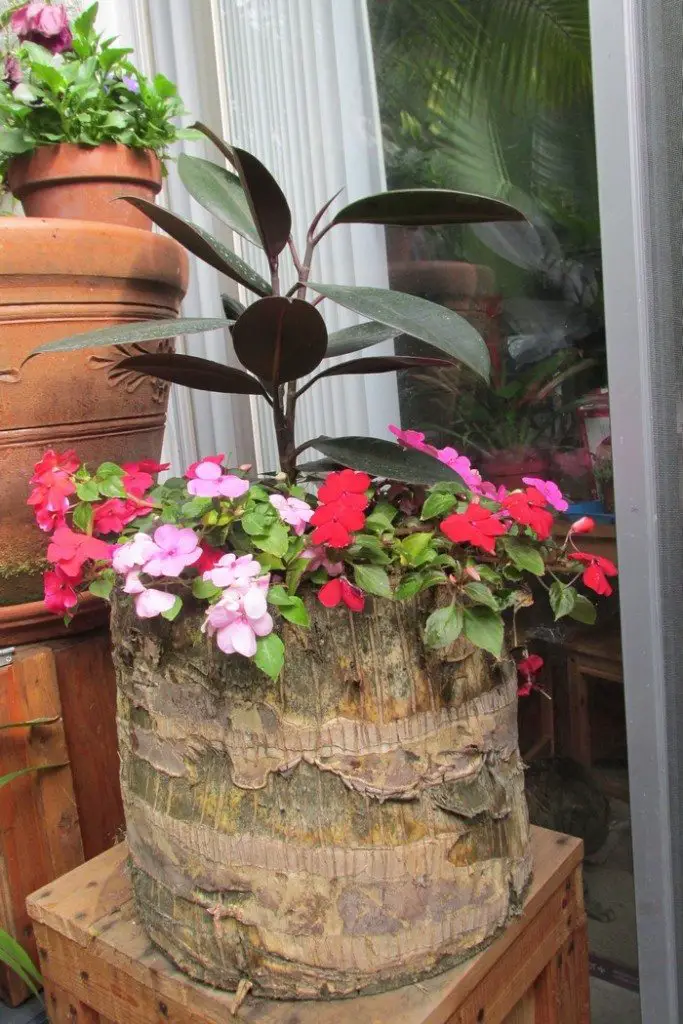
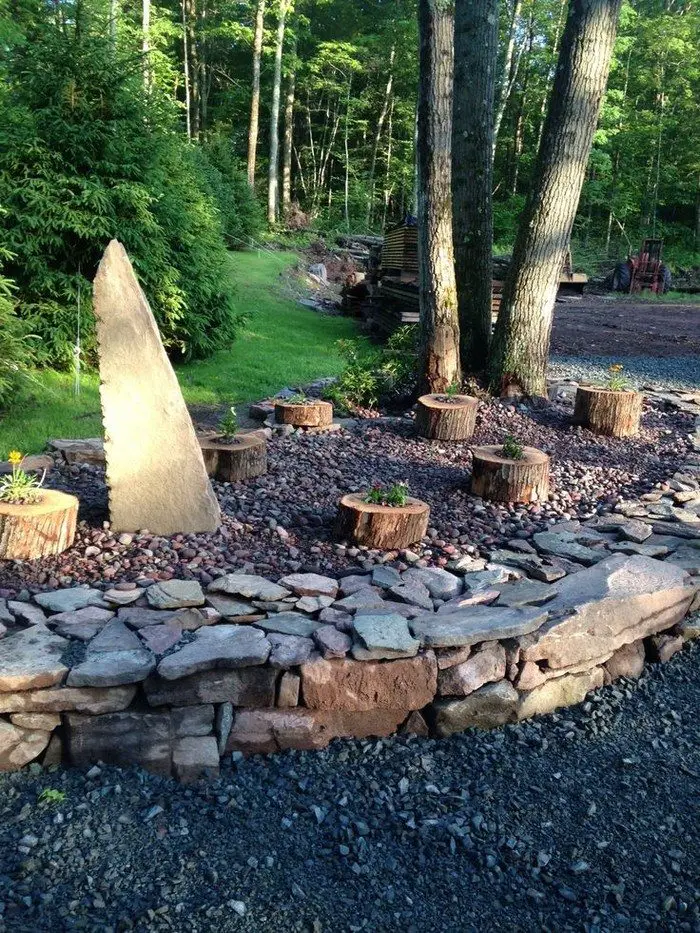
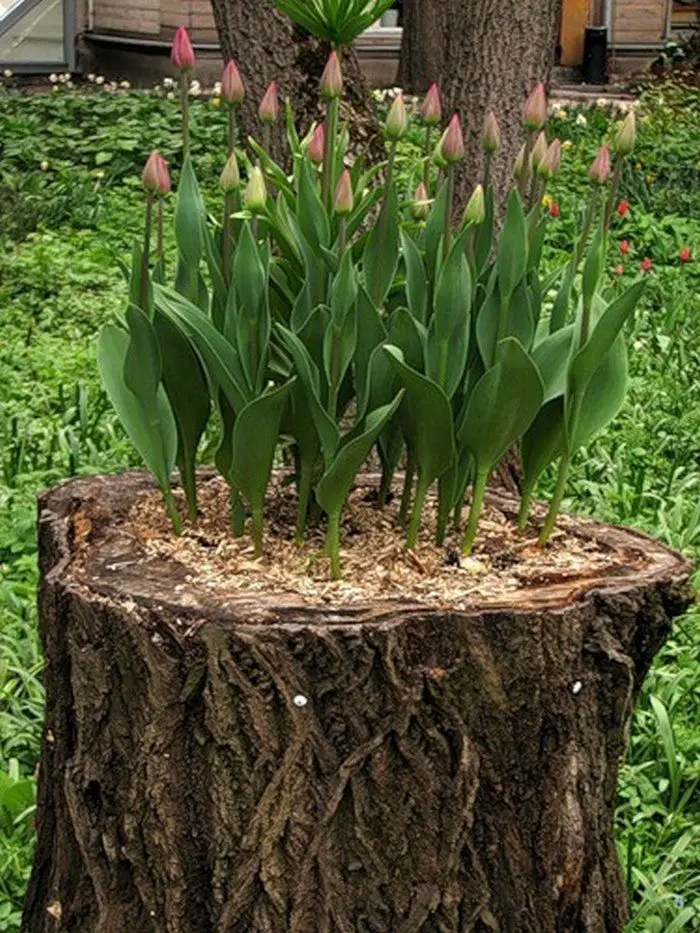
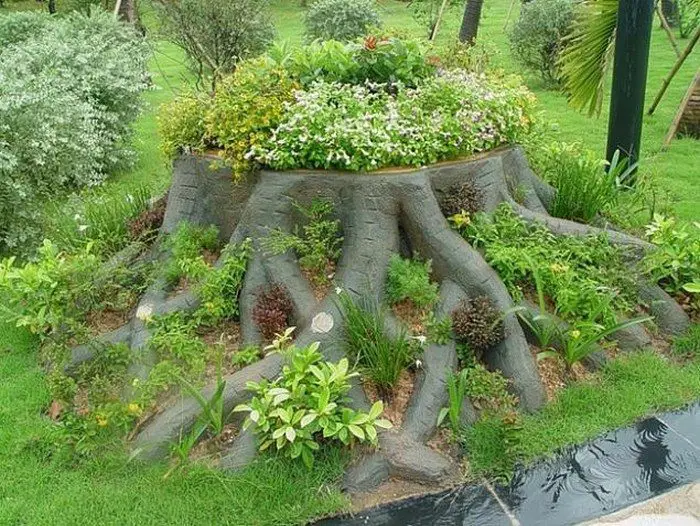
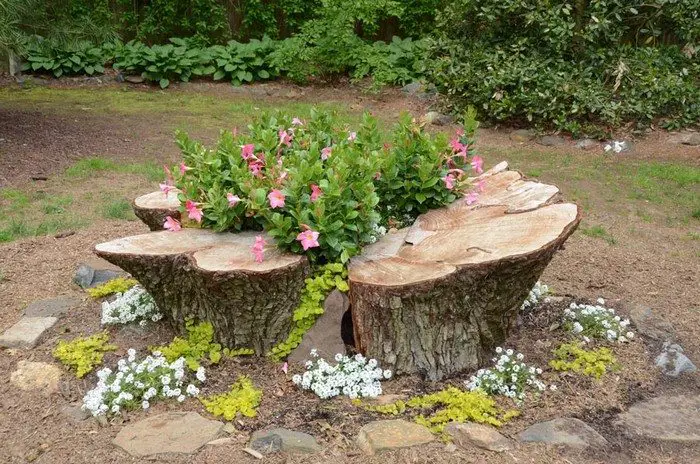
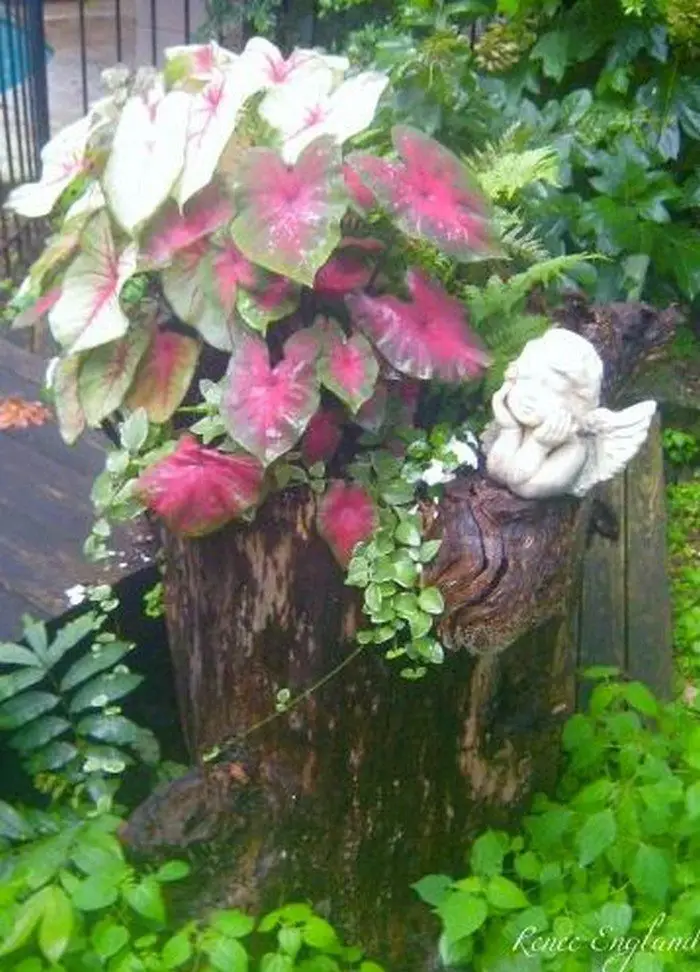

You can get more step-by-step instructions from This Old House over here…
Choosing the Right Tree Stump
Ensuring both the lifetime of the tree stump planter and the health of the plants you want to grow depends on selecting the correct tree stump for your project. Here’s how to choose the ideal stump to turn into a flourishing tree stump planter.
Assess the Tree Species
Regarding durability and resistance to decay, not all wood is made equally. Generally speaking, hardwoods like oak, maple, and ash last longer and offer a sturdier base for a tree stump planter than softer woods like pine or spruce, which often rot faster.
Check for Disease and Pests
Examine a stump carefully for evidence of disease or insect pests before deciding on one. A healthy tree stump will guarantee that diseases and pests won’t spread to your plants and that the tree stump planter will be a useful growing area for many years to come.
Size and Location
Think through the stump’s location and scale. It should be big enough to allow the root systems of the plants you want to use room without crowding. Furthermore, the position of your tree stump planter should get the necessary sunlight for the desired species of plants.
Stump Condition
The state of the stump is first priority. Select a stump with still strong structural sound and roots. Large cracks or splits in a good tree stump planter should not be present since these will eventually cause the stump to break apart.
Choosing the correct tree stump will help you to guarantee that the addition to your garden will be aesthetically pleasing and environmentally friendly.
Preparation and Treatment of the Stump
Transforming the stump into a strong and appealing tree stump planter depends mostly on preparation and treatment. This procedure guarantees that the stump can sustain plants healthily for the next seasons and increase its lifetime. Your tree stump planter should be ready for its new use in your garden as follows.
Cleaning the Stump
Working through any trash, moss, or loose bark from the stump will reveal the raw wood and guarantee correct adherence to any treatments. A tree stump planter kept clean is more rot—and pest-resistant.
Leveling the Stump
Make sure the stump’s top is level so that water and soil can be efficiently held within the planter. Smooth the surface with an axe or saw. A well-leveled tree stump planter will offer the ground and plants a solid foundation.
Applying a Wood Preservative
Apply a wood preservative all around to guard the stump from moisture and decay. Pay especially attention to the hollowed-out top where the planter will be located and any cracks and crevices. By stopping rot, this treatment will greatly prolong the life of your tree stump planter.
Creating a Barrier with Landscaping Fabric
Before laying dirt, line the hollowed-out space with landscaping fabric. This barrier will help prevent soil from coming into direct contact with the wood, lowering the risk of rot and increasing the durability of your tree stump planer.
Sealing the Exterior
Seal the stump’s outside with a weather-resistant sealant for extra protection and to improve its look. This will not only maintain the appearance of the wood but also assist in weatherproofing the tree stump planter, so guaranteeing year-round resilience.
Following these preparation and treatment guidelines will help your tree stump planter accommodate a range of plants, adding a natural and artistic element to your garden scene.
Best Plants for Tree Stump Planters
Choosing the right plants for your tree stump planter is essential to ensure that they thrive and enhance the beauty of your garden. Tree stump planters offer a unique natural container for a variety of plants, blending seamlessly into the landscape while providing an eye-catching feature. Here’s a guide to selecting the best plants for your tree stump planter, taking into consideration their growth needs and visual appeal.
Succulents and Cacti
Due to their minimal soil and water needs, succulents and cacti are ideal for tree stump planters. These plants are well-suited to the shallow and confined spaces of a stump, where excessive moisture can be a concern. Their varied shapes, sizes, and colors can turn a simple stump into a stunning display. Plant varieties like Sempervivum (Hens and Chicks), Sedum, or small cacti for a low-maintenance, drought-resistant garden feature.
Annual and Perennial Flowers
Tree stump planters can get a flash of colour from flowering plants, so defining a strong focal point in your garden. For annuals, think about marigolds, pansies, or petunias, small, vibrant flowers that bloom all during the growing season. For tree stump planters, perennials such as hostas or ferns are also excellent choices particularly if you want longevity and a more permanent fixture in your garden. These year-round returning plants will cover the area with rich, green foliage and sporadic blossoms.
Herbs
Particularly suited to tree stump planters, herb gardens provide both aesthetic and useful advantages. Perfect for the boundaries of a tree stump planter, herbs like thyme, basil, and parsley demand little root space. They not only supply fresh foods for your cooking but also give your garden areas wonderful smells.
Small Shrubs and Bushes
For larger tree stump planters, small shrubs and bushes can be an excellent choice. These plants can give a substantial presence, making the tree stump planter look like a natural part of the landscape. Dwarf varieties of hydrangeas, azaleas, or boxwoods can adapt well to the space limitations of a stump and can contribute significantly to the overall aesthetics of your garden.
Ferns
Ferns are another group of plants that thrive in the moist, shady conditions often found in tree stump planters. Their lush, green fronds add a touch of wilderness and woodsy charm to any garden setting. Ferns like the Lady Fern or Japanese Painted Fern are particularly attractive and thrive with minimal care, making them suitable for both novice and experienced gardeners.
Integrating Plant Varieties
Combining different types of plants can maximize the visual impact of your tree stump planter. Consider the heights, textures, and colors of the plants. Plant taller species in the center and surround them with shorter plants and groundcovers. This strategy not only creates a layered effect but also helps in covering the edges of the stump, integrating the planter more seamlessly into the garden.
Care and Maintenance
Maintaining plants in tree stump planters involves ensuring they receive the right amount of moisture and nutrients. Because the stump can dry out quickly or retain too much moisture depending on the environment, monitoring soil conditions is crucial. Regular watering and occasional fertilization will keep your plants healthy and vibrant.
Tree stump planters provide a creative way to recycle a natural element of your yard into a functional and attractive garden feature. By selecting the right plants, you can transform an ordinary stump into a striking part of your garden that emphasizes sustainability and natural beauty.
Conclusion
One unusual and environmentally friendly approach to transform old stumps into striking garden accents is tree stump planters. These natural planters can become the main point of interest in any landscape with the correct choice of plants and maintenance. Adopting this innovative approach not only improves the appearance of a garden but also encourages a sustainable gardening method.
For more ways on improving the look of your outdoor space, check out our garden path project!





